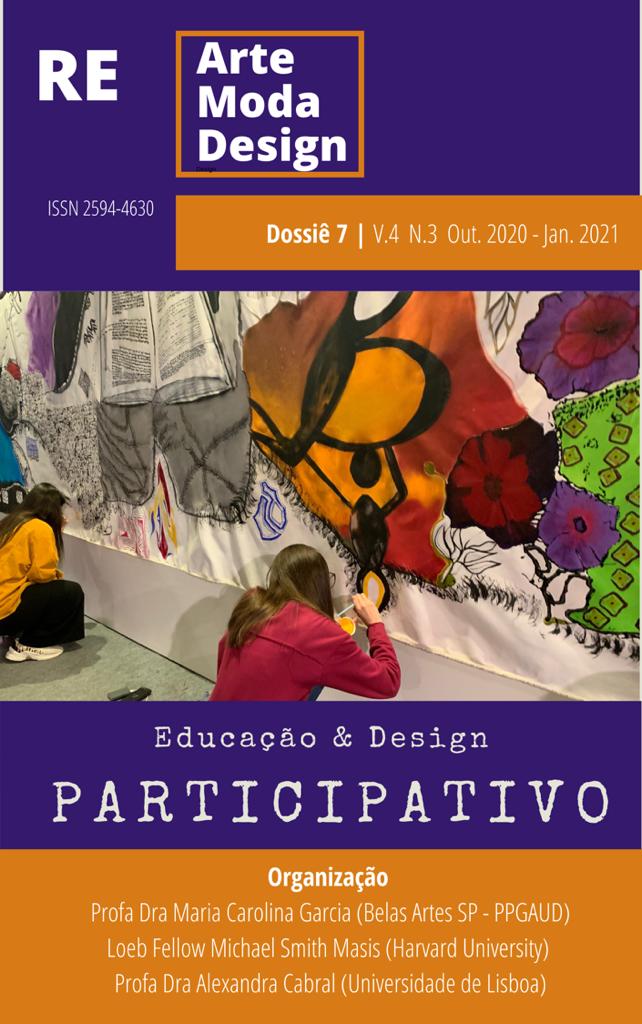Design of a participatory communicational, educational and cultural proposal in the context of teaching-learning
DOI:
https://doi.org/10.5965/25944630432020012Keywords:
communication , education , participationAbstract
This paper aims to discuss the pertinent characteristics for the design of a participatory
model in the communicational, didactic and cultural spheres. For this, it makes use of bibliographic
research, guided by a phenomenological look, resonant with the essayistic form of
expression. It takes different perspectives, of which stand out Martin Buber, Paulo Freire, Juan
Bustos, Vicente Romano, Victor Ventosa, Kristoffer Haggren and Vilém Flusser - the latter,
responsible for the theoretical lens through which we look at design processes. As a result,
it indicates the need for a dialogical and horizontal communication, guided by a model that
educates for participation, celebrates the engagement and the discussion of the agreements
and the necessary stimuli for the teaching-learning contexts.
Downloads
References
BUBER, Martin. Eu e Tu. São Paulo: Moraes, 1974.
BUSTOS, Juan Carlos Miguel de. Comunicación sostenible y desarollo humano em la sociedade de la información. Madrid: Agencia Española de Cooperación Internacional, 2006. Disponível em: https://goo.gl/rRJ8KG. Acesso em: 11 mai. 2018.
CASTELLS, Manoel. A sociedade em rede: a era da informação, v. 1. Rio de Janeiro: Paz e Terra, 1999.
FLUSSER, Vilém. Jogos. Centro Interdisciplinar de Semiótica da Cultura, 9 dez. 1967. Disponível em: https://bit.ly/36ueGPL. Acesso em: 21 mai. 2020.
FLUSSER, Vilém. O mundo codificado: por uma filosofia do design e da comunicação. São Paulo: Cosac Naify, 2007.
FREIRE. Paulo. A importância do ato de ler. São Paulo: Autores Associados/Cortez, 1982.
HAGGREN, Kristoffer et al.. Deltagarkultur. Gotebörg: Interacting Arts, 2009. Disponível em: https://goo.gl/oEtVsx. Acesso em: 13 mar. 2019.
KÜNSCH, D. A.; CARRARA, Renata. Comunicação e pensamento compreensivo: o ensaio como forma de expressão do conhecimento científico. Líbero, São Paulo, v. 15, n. 29, p. 33-42, jun. 2012. Disponível em: https://goo.gl/jgz6Ru. Acesso em: 25 abr. 2018.
MARTINEZ, Monica; SILVA, Paulo Celso da. Fenomenologia: o uso como método em Comunicação. Revista da Associação Nacional dos Programas de Pós-Graduação em Comunicação – E-compós. Brasília, v. 17, n. 2, mai./ago. 2014. Disponível em: https://bit.ly/2zj5EZX. Acesso em: 12 fev. 2016.
PERUZZO, Cicilia Maria Krohling. Apontamentos para Epistemologia e Métodos na Pesquisa em Comunicação no Brasil. Comunicação e Sociedade, Minho, v. 33, 2018, p. 25-40. Disponível em: https://goo.gl/zh9gbA. Acesso em: 28 nov. 2018.
PROSS, Harry. Economia dos sinais e economia política. Centro Interdisciplinar de Semiótica da Cultura, 26 ago. 1997. Disponível em: https://bit.ly/2TsnG2G. Acesso em: 21 mai. 2020.
ROMANO, Vicente. Ecología de la comunicación. Hondarribia: Editorial Hiru, 2004.
SCHWARTZ, Barry. O paradoxo da escolha: por que mais é menos. São Paulo: A Girafa Editora, 2007.
SOUZA, Mauro Araújo de. Brochard e Platão: sobre a teoria da participação (méthexis). Academos – Revista Eletrônica da FIA. São Paulo, v. 1, n. 1, jul.-dez. 2005, p. 70-79. Disponível em: https://bit.ly/2yrwJJM. Acesso em: 24 mai. 2020.
VENTOSA, Victor J.. Didática da participação: teoria, metodologia e prática. São Paulo: Edições SESC, 2016.
WRIGHT, Peter; MCCARTHY, John. Experience-Centered Design: Designers, Users, and Communities in Dialogue. San Rafael: Morgan & Claypool, 2010.
Published
Versions
- 2020-10-01 (2)
- 2020-10-02 (1)
How to Cite
Issue
Section
License
Copyright (c) 2020 Tadeu Rodrigues Iuama, Jorge Miklos

This work is licensed under a Creative Commons Attribution 4.0 International License.
- Authors retain copyright and grant the journal the right of first publication, with work simultaneously licensed under the Creative Commons Attribution 4.0 International License, which allows for:
1. Share — copy and redistribute the material in any medium or format for any purpose, even commercially.
2. Adapt — remix, transform, and build upon the material for any purpose, even commercially.
The licensor cannot revoke these freedoms as long as you follow the license terms.Under the following terms:
1. Attribution — You must give appropriate credit, provide a link to the license, and indicate if changes were made. You may do so in any reasonable manner, but not in any way that suggests the licensor endorses you or your use.
2. No additional restrictions — You may not apply legal terms or technological measures that legally restrict others from doing anything the license permits. -
Plagiarism, in all its forms, constitutes unethical publication behavior and is unacceptable. This magazine uses iThenticate similarity control software.






